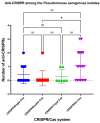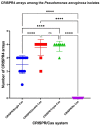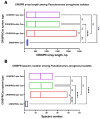CRISPR Element Patterns vs. Pathoadaptability of Clinical Pseudomonas aeruginosa Isolates from a Medical Center in Moscow, Russia
- PMID: 34827239
- PMCID: PMC8615150
- DOI: 10.3390/antibiotics10111301
CRISPR Element Patterns vs. Pathoadaptability of Clinical Pseudomonas aeruginosa Isolates from a Medical Center in Moscow, Russia
Abstract
Pseudomonas aeruginosa is a member of the ESKAPE opportunistic pathogen group, which includes six species of the most dangerous microbes. This pathogen is characterized by the rapid acquisition of antimicrobial resistance, thus causing major healthcare concerns. This study presents a comprehensive analysis of clinical P. aeruginosa isolates based on whole-genome sequencing data. The isolate collection studied was characterized by a variety of clonal lineages with a domination of high-risk epidemic clones and different CRISPR/Cas element patterns. This is the first report on the coexistence of two and even three different types of CRISPR/Cas systems simultaneously in Russian clinical strains of P. aeruginosa. The data include molecular typing and genotypic antibiotic resistance determination, as well as the phylogenetic analysis of the full-length cas gene and anti-CRISPR genes sequences, predicted prophage sequences, and conducted a detailed CRISPR array analysis. The differences between the isolates carrying different types and quantities of CRISPR/Cas systems were investigated. The pattern of virulence factors in P. aeruginosa isolates lacking putative CRISPR/Cas systems significantly differed from that of samples with single or multiple putative CRISPR/Cas systems. We found significant correlations between the numbers of prophage sequences, antibiotic resistance genes, and virulence genes in P. aeruginosa isolates with different patterns of CRISPR/Cas-elements. We believe that the data presented will contribute to further investigations in the field of bacterial pathoadaptability, including antimicrobial resistance and the role of CRISPR/Cas systems in the plasticity of the P. aeruginosa genome.
Keywords: Pseudomonas aeruginosa; WGS; antibiotic resistance; multiple CRISPR/Cas systems; pathoadaptability; virulence factors.
Conflict of interest statement
The authors declare no conflict of interest. The funders had no role in the design of the study; in the collection, analyses, or interpretation of data; in the writing of the manuscript, or in the decision to publish the results.
Figures









Similar articles
-
Interrelation Between Pathoadaptability Factors and Crispr-Element Patterns in the Genomes of Escherichia coli Isolates Collected from Healthy Puerperant Women in Ural Region, Russia.Pathogens. 2024 Nov 14;13(11):997. doi: 10.3390/pathogens13110997. Pathogens. 2024. PMID: 39599550 Free PMC article.
-
Genomic and Phenotypic Analysis of Multidrug-Resistant Acinetobacter baumannii Clinical Isolates Carrying Different Types of CRISPR/Cas Systems.Pathogens. 2021 Feb 13;10(2):205. doi: 10.3390/pathogens10020205. Pathogens. 2021. PMID: 33668622 Free PMC article.
-
Molecular characterization and genome sequencing of selected highly resistant clinical isolates of Pseudomonas aeruginosa and its association with the clustered regularly interspaced palindromic repeat/Cas system.Heliyon. 2025 Jan 6;11(1):e41670. doi: 10.1016/j.heliyon.2025.e41670. eCollection 2025 Jan 15. Heliyon. 2025. PMID: 39866497 Free PMC article.
-
Analysis of direct repeats and spacers of CRISPR/Cas systems type I-F in Brazilian clinical strains of Pseudomonas aeruginosa.Mol Genet Genomics. 2019 Oct;294(5):1095-1105. doi: 10.1007/s00438-019-01575-7. Epub 2019 May 16. Mol Genet Genomics. 2019. PMID: 31098740 Review.
-
Antibiotic-Resistant Pseudomonas aeruginosa: Current Challenges and Emerging Alternative Therapies.Microorganisms. 2025 Apr 16;13(4):913. doi: 10.3390/microorganisms13040913. Microorganisms. 2025. PMID: 40284749 Free PMC article. Review.
Cited by
-
Ultrasensitive CRISPR/Cas12a-Based System for Detection of BlaOXA-1 Gene in Antibiotic-Resistant Microorganisms.Curr Issues Mol Biol. 2025 Mar 29;47(4):238. doi: 10.3390/cimb47040238. Curr Issues Mol Biol. 2025. PMID: 40699637 Free PMC article.
-
Two multidrug-resistant Proteus mirabilis clones carrying extended spectrum beta-lactamases revealed in a single hospital department by whole genome sequencing.Heliyon. 2024 Nov 29;10(23):e40821. doi: 10.1016/j.heliyon.2024.e40821. eCollection 2024 Dec 15. Heliyon. 2024. PMID: 39687096 Free PMC article.
-
Review of CRISPR-Cas Systems in Listeria Species: Current Knowledge and Perspectives.Int J Microbiol. 2022 Apr 23;2022:9829770. doi: 10.1155/2022/9829770. eCollection 2022. Int J Microbiol. 2022. PMID: 35502187 Free PMC article. Review.
-
Interrelation Between Pathoadaptability Factors and Crispr-Element Patterns in the Genomes of Escherichia coli Isolates Collected from Healthy Puerperant Women in Ural Region, Russia.Pathogens. 2024 Nov 14;13(11):997. doi: 10.3390/pathogens13110997. Pathogens. 2024. PMID: 39599550 Free PMC article.
References
-
- WHO . Guidelines for the Prevention and Control of Carbapenem-Resistant Enterobacteriaceae, Acinetobacter baumannii and Pseudomonas aeruginosa in Health Care Facilities. World Health Organization; Geneva, Switzerland: 2017. - PubMed
-
- Edelstein M.V., Skleenova E.N., Shevchenko O.V., D’Souza J.W., Tapalski D.V., Azizov I.S., Sukhorukova M.V., Pavlukov R.A., Kozlov R.S., Toleman M.A., et al. Spread of extensively resistant VIM-2-positive ST235 Pseudomonas aeruginosa in Belarus, Kazakhstan, and Russia: A longitudinal epidemiological and clinical study. Lancet Infect. Dis. 2013;13:867–876. doi: 10.1016/S1473-3099(13)70168-3. - DOI - PubMed
Grants and funding
LinkOut - more resources
Full Text Sources

